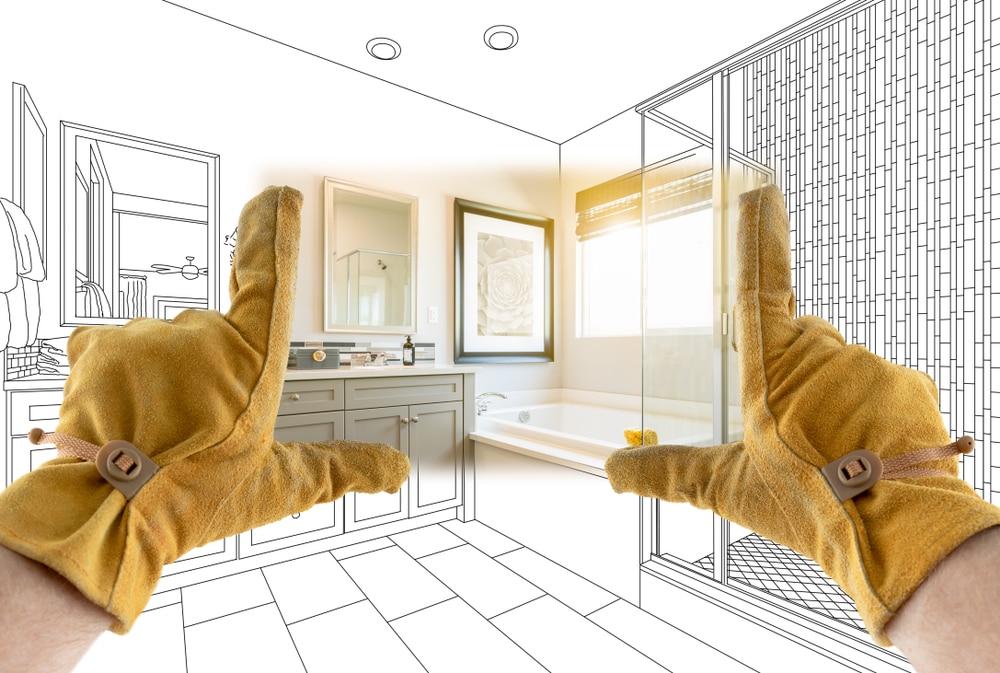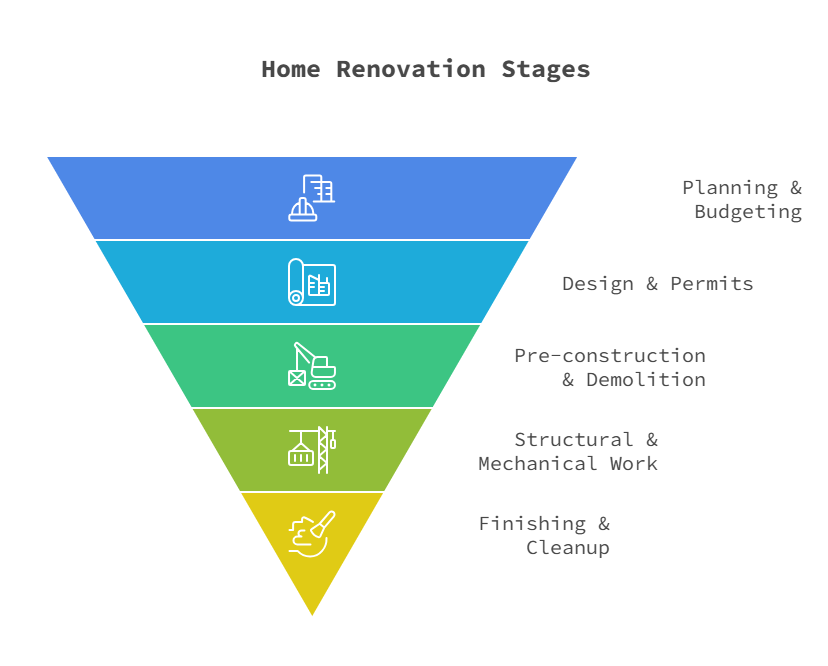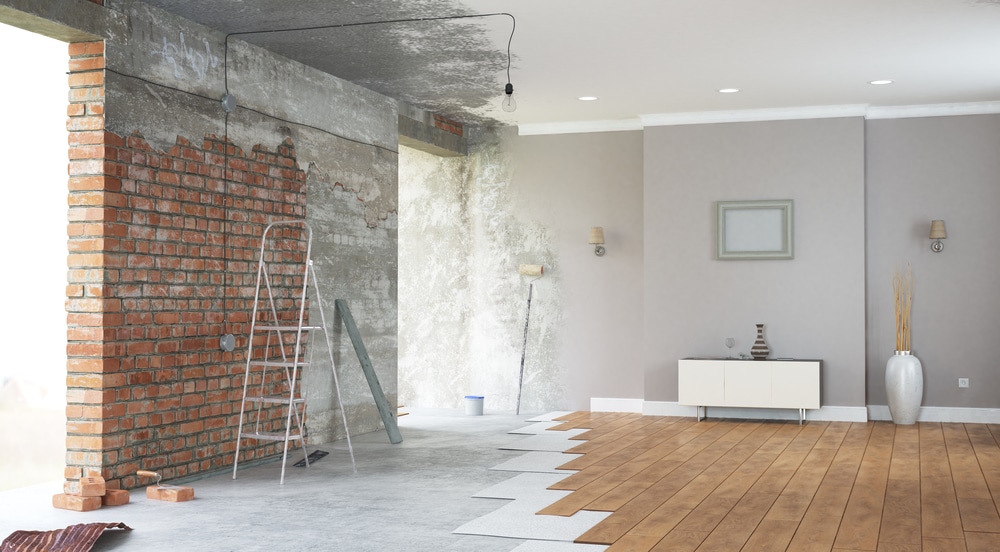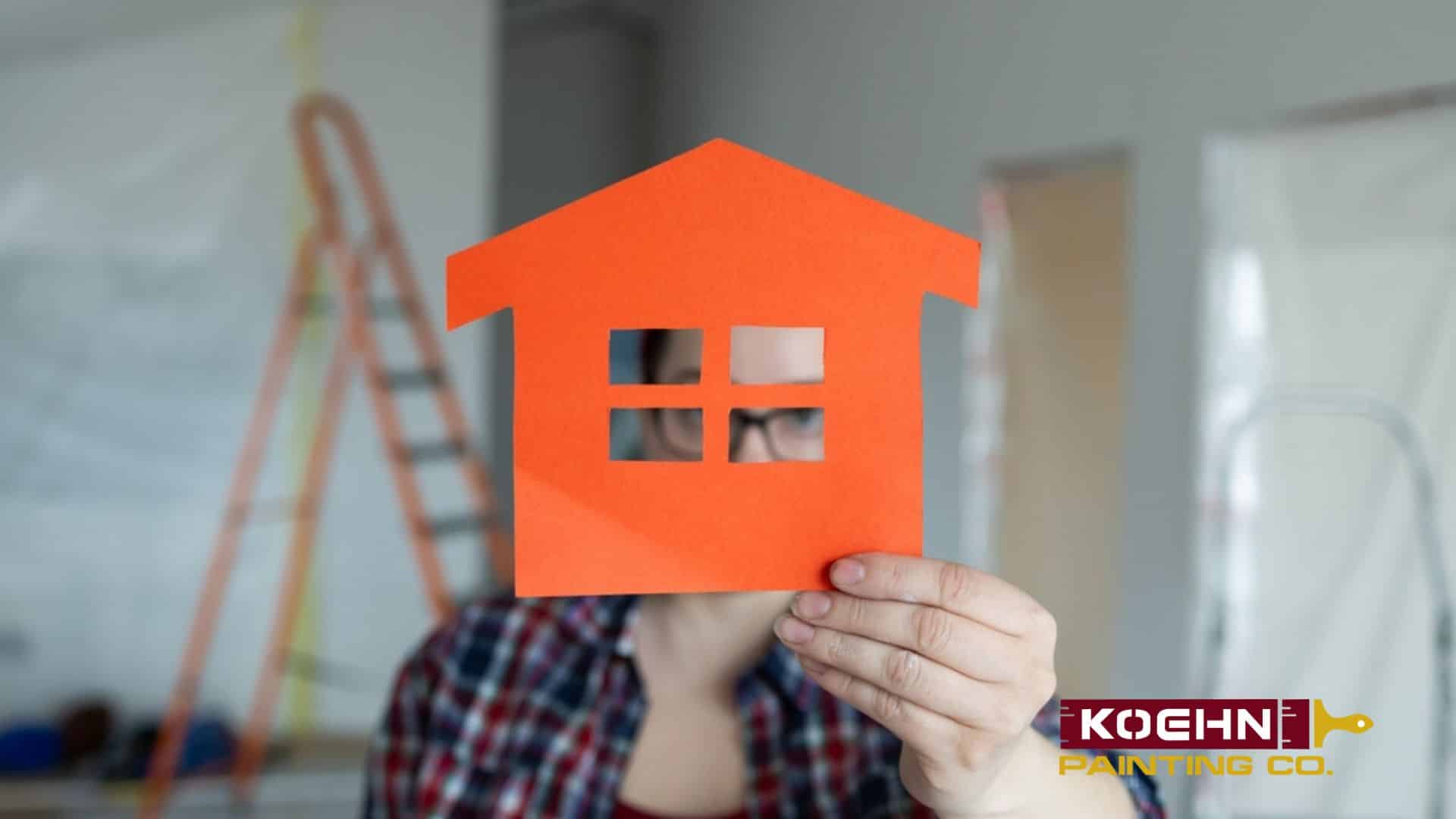Table of Contents
ToggleIf you’ve ever wondered how long does home renovation take, this guide breaks down typical timelines for the most common projects—each job has its own rhythm, but industry patterns emerge:
- Flooring Installation: Tasks like engineered vinyl or click-lock usually complete within 2–3 days for a 1,000 sq ft area. Hardwood or tile installations typically take 3–5 days, plus an additional 2–3 days for wood acclimation or tile setting.
- Kitchen Updates: Surface-level makeovers—such as fresh paint, new cabinet fronts, or minor fixtures—can be completed in under a week. A full mid-range remodel—new cabinets, plumbing, electrical work, and custom countertops—takes about 6–12 weeks for construction, plus 3–6 months for design, permits, and lead times.
- Bathroom Projects: Small secondary baths typically take 2–3 weeks. Larger primary bathrooms—especially with dual vanities, custom tile, or frameless glass—may last 8–10 weeks from demo to final fixtures.
- Basement Finishes: Expect 4–8 weeks for a standard finish, though moisture remediation, structural work, or scope changes can extend the timeline.
- Painting (Interior & Exterior): One room can often be completed in a day; a full-house painting usually takes 5–10 days, mainly depending on prep work and weather conditions outside.
- Roofing and window replacements: Easy shingle or window swaps can be completed in days; full re-roofing or custom window installations might take several weeks if underlying damage is found.
Overall, a complete gut remodel usually takes 12–16 weeks for minor adjustments or 20–30 weeks for large-scale overhauls—around five to seven months from initial concept to move-in. Timelines can sometimes stretch longer because of permit delays, back-ordered materials, hidden damage, design changes, weather, or contractor problems.
Building in buffers, finalizing designs early, ordering long-lead items upfront, and maintaining tight communication can help keep projects on track. For DIY renovators, expect at least double the professional timeline, as part-time work and skill learning cause significant delays. Let’s dive deeper into this.
Home Renovation Timeline by Project Type

If you’re wondering how long does home renovation take, you’re not alone, and you’re definitely not the first to get a wildly different answer depending on who you ask. The truth is, every renovation has its own rhythm. Still, some patterns emerge.
To help you plan better—and avoid surprises—we’ve broken down the home renovation timeline for the most common projects. Whether you’re installing new floors, remodeling your bathroom, or painting the exterior, this guide gives you realistic expectations based on industry standards and real-world averages. No sugarcoating. One by one.
Flooring Installation
Installing new flooring is one of the fastest ways to refresh your home, and one of the more predictable in terms of timelines. But time can still vary depending on the material and whether you’re removing old flooring first.
- Hardwood or engineered hardwood typically takes 3–5 days for installation in a standard 1,000 sq ft area. Add 2–3 days before the job even starts for the planks to acclimate to your home’s humidity. Skip this step, and you risk warping.
- Engineered click-lock and luxury vinyl often install in just 2–3 days, especially in newer homes with even subfloors.
- A tile flooring job typically takes 3–5 days, depending on the layout complexity and the drying time between layers (thinset, grout, and sealant). Intricate designs or mosaics will add to the timeline.
If the job involves tearing out old carpet, leveling subfloors, or correcting squeaks, tack on a few extra days. All told, most flooring projects—from demo to finish—wrap up in 1 to 3 weeks.
Kitchen Remodel
How long does home renovation take when it involves a kitchen? Probably longer than you’d hope—but for good reason.
- A mid-range kitchen remodel—think new cabinets, counters, fixtures, and appliances—takes roughly 6–12 weeks of construction. That’s just the build.
- Add planning time, ordering custom pieces, and waiting on permits or inspections, and the total project stretches to 3–6 months.
- If you’re just doing surface-level updates—like swapping cabinet doors or installing a new backsplash—you could finish in 3–5 days, assuming no surprises.
We’ve seen kitchen timelines double just because a quartz countertop was backordered or the homeowner decided to change the tile midway. Kitchen remodels are complex ecosystems; plumbing, electrical, cabinetry, and design all need to sync up.
Bathroom Remodel
Bathrooms are small but mighty, and can easily balloon in scope.
- A standard guest or half-bath can be remodeled in 2–3 weeks, assuming materials are ready and there’s no water damage hiding behind the walls.
- For larger primary bathrooms with dual vanities, walk-in showers, and heated floors, 6–10 weeks isn’t unusual.
Complications often arise from plumbing or custom tile work. And if you’re relocating fixtures—like turning a tub into a shower—that means permits and inspections, which always add time.
Basement Finishing
Turning an unfinished basement into a livable space is a great investment but it’s also one of the most time-intensive projects.
- A full build-out with insulation, drywall, recessed lighting, bathroom plumbing, and new flooring usually takes 4–8 weeks of actual construction.
- However, if the space is older or has moisture issues, you’ll need to factor in remediation time upfront.
Basement jobs tend to creep when homeowners decide mid-project to add a bar area, office nook, or in-law suite. Planning thoroughly before you start is key.
Interior Painting
Painting your interior can be one of the quickest renovations, if the prep work is minimal. A single room can be done in a day, but a whole house is another story.
- A full interior repaint typically takes 2–7 days, depending on size, height of ceilings, trim complexity, and whether furniture needs to be moved.
- Specialty finishes, accent walls, or color changes (from dark to light) require extra coats and more drying time.
Exterior Painting
This one depends heavily on weather conditions and siding type.
- Expect 5–10 days for a standard-size home, from pressure washing to final coat.
- Stucco or homes with peeling paint will require extra prep, which can tack on several days.
Keep in mind: consistent dry weather is a must. One rainy day can delay a job by two.
Roof Replacement
This is surprisingly quick if everything goes according to plan.
Most roof replacements are done in 1–3 days, assuming dry conditions and no hidden issues beneath the shingles. However, if the plywood decking is damaged or there’s water infiltration, expect delays while those areas are repaired.
Window Replacement
Replacing windows seems simple, but measurements and customization can complicate things.
- Swapping out a few standard-sized windows? You’re looking at 1–3 days.
- Larger jobs with custom shapes, new framing, or historical considerations can take 1–2 weeks, especially if permits are required.
Whole-Home Flooring Refinishing
If your hardwoods are looking dull or scratched, refinishing might be all you need.
- Sanding, staining, and sealing an entire home’s worth of floors usually takes 3–7 days.
- You’ll need to vacate during this time, as the fumes and dust aren’t safe for daily living.
Drying times vary based on the finish (oil-based vs. water-based), and adding patterns or borders extends the timeline.
Deck Building or Remodel
Adding or upgrading a deck can enhance your home’s value and functionality, but it’s weather-sensitive and permit-heavy.
- A standard deck build takes 1–3 weeks, depending on size, design complexity, and material availability.
- Composite materials often have longer lead times. And if you’re working with a sloped yard or adding electrical (for lighting), you’ll need more prep.
Each project has its own set of moving parts, but with proper planning and clear expectations, you can confidently answer the question: how long does a home renovation take for your house?
Contact us here if you would like to find the best painting contractor for your residential or commercial painting needs.
What a Total Home Renovation Timeline Looks Like

When considering a total home renovation, the question “how long does home renovation take?” becomes complex, but rest assured, there’s a logical progression to these big projects
So, what are the 5 stages of home renovation? In this section, we’ll walk you through each phase using a clear framework and real-world timelines, showing you exactly what to expect from first ideas to final move-in.
Stage 1: Initial Planning & Budgeting (2–6 weeks)
This foundational stage defines your project’s success. You’ll list everything you want—from a fresh kitchen to a new deck—and decide what really matters. It’s also when you set your budget, identifying where you’re willing to splurge and where you’ll save.
This crucial planning and budgeting phase helps clarify your vision and filter ideas by feasibility.
Typical timeline: 2–6 weeks, depending on your decision speed and whether you loop in a designer or grow your scope.
Stage 2: Design & Permits (4–12 weeks)
Once your plan is solid, it’s time for design and approvals. That means working with a designer, doing detailed layouts, picking materials, and finalizing looks. If structural changes are involved, you’ll need to submit plans and get permits. This phase can stretch if your project is large or if your municipality has a backlog.
Estimated duration: 4–12 weeks (longer in busy regions).
Stage 3: Pre-construction Prep & Demolition (1–4 weeks)
Before hammers swing, there’s prep:
- Documentation: Take photos as proof against accidental damage.
- Moving and staging: Clear the work area; possibly set up temporary living quarters.
- Demo: Tearing down walls, ripping out old materials—this can be fast-paced or messy, depending on the job.
Time estimate:
- Pre-construction prep: 1–2 weeks
- Demolition: 1–2 weeks
Stage 4: Structural, Mechanical & Structural Work (4–12 weeks)
This is the “bones” phase—electrical, plumbing, insulation, framing, HVAC placement, drywall, and rough inspections all happen here. Matterport breaks it into:
- Structural work (framing, load-bearing changes)
- Mechanicals (plumbing, electrical, HVAC)
- Wall installations (insulation, drywall mud and tape
Complex whole-home projects often wrap in 4–12 weeks, but scope changes and inspections can push this longer.
Stage 5: Finishes, Fixtures & Final Touches (4–8 weeks)
Time to get visual—installing flooring, painting, cabinets, counters, trim work, appliances, fixtures, and lighting. Then come the final inspections, punch-list fixes, and a comprehensive cleanup.
Timeline: Roughly 4–8 weeks, depending on size and detail.
Putting these stages side-by-side:
- Minimal gut renovation: 12–16 weeks
- Full home overhaul: 20–30 weeks
That’s 5–7 months, from first sketches to the day you move in. As one builder points out, permits, inspection delays, and change orders can stretch timelines from expected 8–10 weeks to even longer

If you’re wondering how long it takes to renovate a house on your own, be prepared. DIYers often face longer timelines due to fewer workers, working part-time, learning new skills, and dealing with permitting issues. It’s common for a solo homeowner to take twice or even more time than a professional-led project. With unpredictable delays and the amount of work involved, a DIY whole-home renovation becomes a marathon, not a sprint.
A total home renovation timeline isn’t fixed, but most large-scale remodels take between five and seven months, from dreaming to unpacking. Knowing the 5 stages of home renovation provides structure, and understanding each phase helps you estimate how long home renovation takes for your specific project.
Bonus Tip: Add a visual timeline graphic (if formatting allows) to help homeowners picture the phases.
Top Reasons Your Renovation Timeline Might Slide
Even the best-laid renovation plan can hit a few speed bumps. These common issues can derail your home renovation timeline:
- Permit & inspection hold-ups. Many projects grind to a halt when city approvals or inspections fall behind. Strict boards can delay sign-off or require resubmissions, costing weeks.
- Extended lead times for custom materials. Fancy finishes like handmade tiles or quartz slabs require time to produce. If they’re back-ordered, your project may be delayed, sometimes for months.
- Hidden damage was uncovered mid-build. Once you peel back walls or flooring, you might find mold, rot, or outdated wiring. Scheduling repairs on the fly adds both time and money.
- Scope creep & design changes. Adjusting your plans mid-reno—like swapping countertop styles or adding features—can stall progress while the team reorders materials and revises permits.
- Unreliable crews or miscommunication. Contractors who show up late, skip days, or juggle too many projects can stall your timeline. Without clear communication and accountability (like milestone payments), avoidable delays creep in.
- Weather & seasonal slowdown. Rain, extreme heat, and cold can wreck schedules, especially for roofing, exterior work, and pouring concrete.
How to Keep Your Home Project Moving Smoothly
Here are practical strategies to keep your renovation on schedule and on budget:
- Finalize designs & materials before work begins. Lock in specs, colors, and finishes early to avoid change orders. When everyone knows exactly what’s needed, the build flows better.
- Order long-lead items early. Appliances, custom cabinetry, lighting? Order them at the start and track delivery closely. Have backups ready in case of delays.
- Build in time buffers. Add a 10–15% timeline cushion for permit delays, inspections, or bad weather. It helps keep everyone focused without panic.
- Choose a contractor with local knowledge. A pro familiar with your area knows the ins and outs of permitting and weather trends, key to avoiding setbacks.
- Maintain tight communication. Set up weekly check-ins, update in writing, and use milestone-based contracts with leverage for missed deadlines.
- Prep ahead if you’re living through it. Protect furniture, set up zones you can still use, and plan meals and living logistics that fit the construction schedule.
How Long Does Home Renovation Take: Conclusion

So, how long does home renovation take? As you’ve seen, the answer depends on your project’s size, complexity, and planning precision. From a weekend paint job to a full gut renovation stretching seven months, timelines vary—but patterns and phases remain consistent.
The smartest homeowners approach renovation like a project manager: with clear stages, buffer time, and strong communication. They don’t just ask “how long will this take?”—they ask, “What could delay it?” and “How do I stay ahead?”
Whether you’re refreshing one room or rebuilding an entire home, success lies in expectation management. Finalize designs early. Lock in your contractor and key materials. Respect the process—and don’t forget to build in grace for the unexpected.
Because at the end of the day, it’s not just about how long a renovation takes. It’s about how confidently, efficiently, and calmly you move through it—so the home you imagined becomes the home you live in.
Discover the Koehn Painting difference – contact us today for a free estimate and step into a vibrant, freshly painted home!




